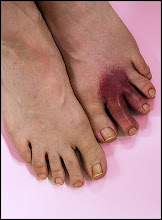A few more words at random on the Lumix LX1 and what used to be called "candid" photography, or "available-light" p., and more recently "street" or "documentary" photography – you know, unposed and unlit photos of unaware people in public places, handheld and usually in black-and-white. That kind of photography's not my specialty; I'm pathologically shy. But I can do it, after a fashion, in touristy surroundings where everybody else is taking pictures too.
I've spent a lot of time over the last eight years keeping an eye out for good "candid" equipment, and came close to finding it with the Contax G2, Fuji Neopan 400 pushed to 1600 in TMax, and the Zeiss-G lenses. True, the G2 was noisy, its view/rangefinder sucked like a Hoover, and its optically superb lenses had problems with autofocus. ("Problems" covers a lot of sins, not just focusing failure. For example, in autofocus mode the G2 wouldn't release the shutter until focus was acquired. And after each exposure in single-frame shooting the focus would return to some zero point, requiring re-focusing for the next shot.) But I was very fond of it and sold it with regret, as part of a Brand-ish, all-or-nothing change from film to digital.
I also used, with good results, a Ricoh GR1, the cult-classic P&S with a fixed 28mm lens. A gem, but it was limited by that single focal length, and went the way of all my film equipment.
Quality digital P&S cams have many good points as "candid" cameras. They're tiny, unobtrusive, absolutely silent, and look like any tourist snapper. Some, like the LX1, have excellent zoom lenses, a clear advantage over rangefinders. However, those lenses are slow – the LX1's f/2.8 is considered fast in the P&S context – and tiny cameras have tiny digital sensors that aren't very sensitive to light. Boosting their electrical output means boosting random noise too, so in practice you're limited to ISO 100 or 200, three or four stops short of the 1600 most "street" shooters are used to. The combination of slow lens and low ISO bodes ill for available-light photography. I often find myself shooting wide open at speeds longer than a quarter of a second. Few of us can hold a flyweight camera still that long, even if we stick to wide angle.
Another serious drawback is the lack of a usable viewfinder. Many quality digicams (including the LX1) rely entirely on the LCD display, which means you wind up holding the cam out in a gesture that's hard to miss. If you need reading glasses, you'll have to put them on to make a photo – diopter correction impossible. And finally, no LCD works worth a damn in bright sunlight, where framing is by guess and by gosh.
Speed of operation is compromised too, at least if you insist on RAW files. (I do.) Tiny cam, tiny buffer – typically not big enough for even one such image. The LX1 doesn't compress RAW files, or so it seems: they're enormous, 16 megs plus another meg for the obligatory JPG. Writing that many bits to the newest and fastest storage cards takes three seconds or so, a lot longer than winding a Leica. During that interval you cannot take another picture. Best to close your eyes and count to three, so you don't see what you're missing. It might break your heart.
Progress is being made, of course. Many digicams now feature image stabilization. Panasonic claims this adds three stops, e.g. if you can hold at 1/30 without IS, with it you can handle 1/4, and I find that this isn't an exaggeration. (But IS can't stop subject motion, which is almost always a factor you need to deal with in street shots. ) The rush to cram more pixels (hence smaller ones, hence more noise) onto tiny sensors seems to be abating, since the difference between six and eight megapixels, much less between eight and nine, is nearly impossible to see in lettersize prints. Maybe now the big brands will turn their attention to making each pixel more sensitive. I well remember when the fastest film available was rated at ISO 125, and things happen faster in consumer electronics than they did in consumer chemistry.
Mind you, I'm pleased with the LX1. I've made a few photos with it that I think are pretty good. But using it for street work is a tour de force, like doing surgery with a linoleum knife. Oops!
There are rumors of an LX2, and hope springs eternal. But the new god is not yet. Nor am I about to go back to the old dispensation, where image stabilization means a tripod and every lens is prime. As the guys in that play kept saying, there's nothing to be done but wait for Godot.

